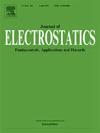Effects of voltage, frequency, and pulse parameters on mercury oxidation efficiency in pulsed corona discharge
IF 2.1
4区 工程技术
Q3 ENGINEERING, ELECTRICAL & ELECTRONIC
引用次数: 0
Abstract
Plasma-based methods for Hg removal exhibit advantages such as low cost and environmental friendliness. A nanosecond-pulse-driven corona discharge single-cylinder system was established to study the effects of discharge parameters—voltage, frequency, pulse width, and rise time—on the oxidation efficiency of Hg. The oxidation efficiency of Hg was calculated by measuring the Hg0 concentration using a cold vapor atomic absorption spectrometer (CVAAS), while the voltage and current of the corona discharge were measured via a high-voltage probe and a current coil to calculate the power density. The experimental results indicated that the oxidation rate of Hg0 was positively correlated with the voltage, frequency, and pulse width of the power source in the tested ranges, but not with the rising edge. The most important parameter is the energy density in the discharge plasma, which increases with voltage, frequency, and pulse width, showing a logarithmic-exponential function between the oxidation rate and energy density. An Hg0 removal rate of 90 % or more can be reached when the energy density is more than 9.81 J/L and a maximum rate of 97.84 % can be achieved under voltage of 15.1 kV, frequency of 200 Hz and pulse width of 200ns in the current work. The findings of this research are helpful in the design of a pulsed corona discharge system for the removal of Hg0 pollutants.
电压、频率和脉冲参数对脉冲电晕放电中汞氧化效率的影响
等离子体除汞技术具有成本低、环境友好等优点。建立了纳秒脉冲驱动电晕放电单缸系统,研究了放电参数电压、频率、脉宽和上升时间对汞氧化效率的影响,利用冷蒸汽原子吸收光谱仪(CVAAS)测量汞浓度计算汞的氧化效率,通过高压探头和电流线圈测量电晕放电的电压和电流,计算出功率密度。实验结果表明,在测试范围内,Hg0的氧化速率与电源电压、频率和脉宽呈正相关,而与上升沿无关。最重要的参数是放电等离子体中的能量密度,它随电压、频率和脉冲宽度的增加而增加,在氧化速率和能量密度之间表现出对数指数函数。当能量密度大于9.81 J/L时,Hg0去除率可达90%以上,在当前工作电压为15.1 kV、频率为200 Hz、脉宽为200ns时,Hg0去除率最高可达97.84%。研究结果对脉冲电晕放电去除Hg0污染物系统的设计具有一定的指导意义。
本文章由计算机程序翻译,如有差异,请以英文原文为准。
求助全文
约1分钟内获得全文
求助全文
来源期刊

Journal of Electrostatics
工程技术-工程:电子与电气
CiteScore
4.00
自引率
11.10%
发文量
81
审稿时长
49 days
期刊介绍:
The Journal of Electrostatics is the leading forum for publishing research findings that advance knowledge in the field of electrostatics. We invite submissions in the following areas:
Electrostatic charge separation processes.
Electrostatic manipulation of particles, droplets, and biological cells.
Electrostatically driven or controlled fluid flow.
Electrostatics in the gas phase.
 求助内容:
求助内容: 应助结果提醒方式:
应助结果提醒方式:


